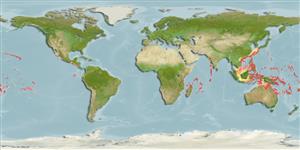Actinopterygii (ray-finned fishes) >
Beryciformes (Sawbellies) >
Holocentridae (Squirrelfishes, soldierfishes) > Holocentrinae
Etymology: Neoniphon: Greek, neos = new + Greek, niphon = to snow (Ref. 45335).
Environment / Climate / Range
Ecology
Marine; reef-associated; depth range 30 - 188 m (Ref. 89972), usually 40 - 70 m (Ref. 4201). Tropical, preferred ?; 32°N - 24°S
Indo-Pacific: Mauritius, Reunion, and the Comoros to the Hawaiian and Marquesan islands, north to southern Japan, sourth to the Great Barrier Reef (Ref. 37816).
Size / Weight / Age
Maturity: Lm ? range ? - ? cm
Max length : 25.0 cm TL male/unsexed; (Ref. 9710)
Dorsal
spines
(total): 11;
Dorsal
soft rays
(total): 12-14;
Anal
spines: 4;
Anal
soft rays: 8 - 9. Only species of Neoniphon that has yellow body stripes, 3.5 instead of 2.5 scale rows above the lateral line, and a last dorsal spine that is shorter than the second to the last one.
Confined to outer reef slopes (Ref. 1602). Rarely occurring in less than 40 m depth, in current prone areas (Ref. 48635). Feeds on crustaceans (Ref. 89972). Benthopelagic in or near crevices or caves at 30-188 m (Ref. 58302). Solitary or in small groups (Ref 90102).
Life cycle and mating behavior
Maturity | Reproduction | Spawning | Eggs | Fecundity | Larvae
Randall, J.E. and C. Heemstra, 1985. A review of the squirrelfishes of the subfamily Holocentrinae from the western Indian Ocean and Red Sea. Ichthyol. Bull. J.L.B. Smith Inst. Ichthyol. (49):1-29. (Ref. 7459)
IUCN Red List Status (Ref. 115185)
CITES (Ref. 94142)
Not Evaluated
Threat to humans
Harmless
Human uses
More information
Common namesSynonymsMetabolismPredatorsEcotoxicologyReproductionMaturitySpawningFecundityEggsEgg development
ReferencesAquacultureAquaculture profileStrainsGeneticsAllele frequenciesHeritabilityDiseasesProcessingMass conversion
Tools
Special reports
Download XML
Internet sources
Estimates of some properties based on models
Phylogenetic diversity index (Ref.
82805): PD
50 = 0.5312 [Uniqueness, from 0.5 = low to 2.0 = high].
Trophic Level (Ref.
69278): 4.0 ±0.66 se; Based on food items.
Resilience (Ref.
69278): High, minimum population doubling time less than 15 months (Preliminary K or Fecundity.).
Vulnerability (Ref.
59153): Low vulnerability (19 of 100) .
